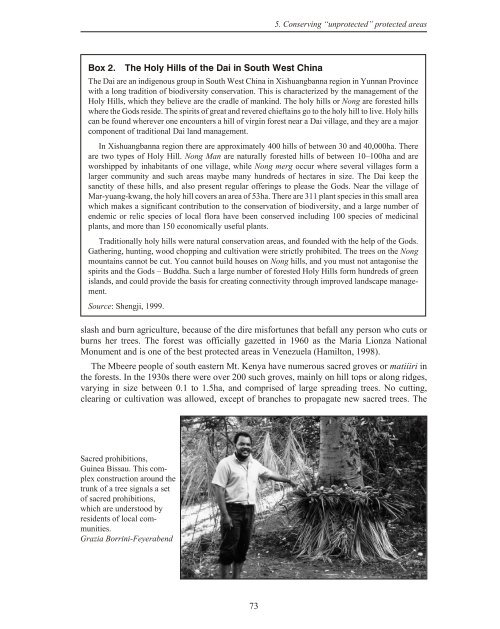The Protected Landscape Approach - Centre for Mediterranean ...
The Protected Landscape Approach - Centre for Mediterranean ...
The Protected Landscape Approach - Centre for Mediterranean ...
You also want an ePaper? Increase the reach of your titles
YUMPU automatically turns print PDFs into web optimized ePapers that Google loves.
5. Conserving “unprotected” protected areas<br />
Box 2.<br />
<strong>The</strong> Holy Hills of the Dai in South West China<br />
<strong>The</strong> Dai are an indigenous group in South West China in Xishuangbanna region in Yunnan Province<br />
with a long tradition of biodiversity conservation. This is characterized by the management of the<br />
Holy Hills, which they believe are the cradle of mankind. <strong>The</strong> holy hills or Nong are <strong>for</strong>ested hills<br />
where the Gods reside. <strong>The</strong> spirits of great and revered chieftains go to the holy hill to live. Holy hills<br />
can be found wherever one encounters a hill of virgin <strong>for</strong>est near a Dai village, and they are a major<br />
component of traditional Dai land management.<br />
In Xishuangbanna region there are approximately 400 hills of between 30 and 40,000ha. <strong>The</strong>re<br />
are two types of Holy Hill. Nong Man are naturally <strong>for</strong>ested hills of between 10–100ha and are<br />
worshipped by inhabitants of one village, while Nong merg occur where several villages <strong>for</strong>m a<br />
larger community and such areas maybe many hundreds of hectares in size. <strong>The</strong> Dai keep the<br />
sanctity of these hills, and also present regular offerings to please the Gods. Near the village of<br />
Mar-yuang-kwang, the holy hill covers an area of 53ha. <strong>The</strong>re are 311 plant species in this small area<br />
which makes a significant contribution to the conservation of biodiversity, and a large number of<br />
endemic or relic species of local flora have been conserved including 100 species of medicinal<br />
plants, and more than 150 economically useful plants.<br />
Traditionally holy hills were natural conservation areas, and founded with the help of the Gods.<br />
Gathering, hunting, wood chopping and cultivation were strictly prohibited. <strong>The</strong> trees on the Nong<br />
mountains cannot be cut. You cannot build houses on Nong hills, and you must not antagonise the<br />
spirits and the Gods – Buddha. Such a large number of <strong>for</strong>ested Holy Hills <strong>for</strong>m hundreds of green<br />
islands, and could provide the basis <strong>for</strong> creating connectivity through improved landscape manage -<br />
ment.<br />
Source: Shengji, 1999.<br />
slash and burn agriculture, because of the dire mis<strong>for</strong>tunes that befall any person who cuts or<br />
burns her trees. <strong>The</strong> <strong>for</strong>est was officially gazetted in 1960 as the Maria Lionza National<br />
Monument and is one of the best protected areas in Venezuela (Hamilton, 1998).<br />
<strong>The</strong> Mbeere people of south eastern Mt. Kenya have numerous sacred groves or matiiiri in<br />
the <strong>for</strong>ests. In the 1930s there were over 200 such groves, mainly on hill tops or along ridges,<br />
varying in size between 0.1 to 1.5ha, and comprised of large spreading trees. No cutting,<br />
clearing or cultivation was allowed, except of branches to propagate new sacred trees. <strong>The</strong><br />
Sacred prohibitions,<br />
Guinea Bissau. This com -<br />
plex construction around the<br />
trunk of a tree signals a set<br />
of sacred prohibitions,<br />
which are understood by<br />
residents of local com -<br />
munities.<br />
Grazia Borrini-Feyerabend<br />
73

















